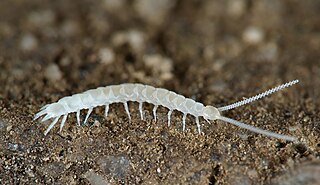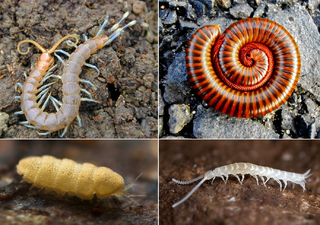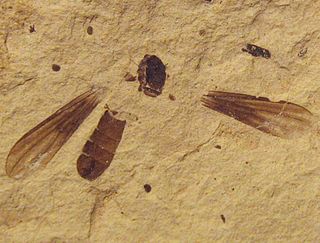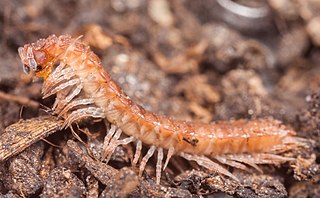
Pauropoda is a class of small, pale, millipede-like arthropods in the subphylum Myriapoda. More than 900 species in twelve families are found worldwide, living in soil and leaf mold. Pauropods look like centipedes or millipedes and may be a sister group of the latter, but a close relationship with Symphyla has also been posited. The name Pauropoda derives from the Greek pauros and pous or podus, because most species in this class have only nine pairs of legs as adults, a smaller number than those found among adults in any other class of myriapods.

Symphylans, also known as garden centipedes or pseudocentipedes, are soil-dwelling arthropods of the class Symphyla in the subphylum Myriapoda. Symphylans resemble centipedes, but are very small, non-venomous, and only distantly related to both centipedes and millipedes. More than 200 species are known worldwide.

Myriapods are the members of subphylum Myriapoda, containing arthropods such as millipedes and centipedes. The group contains about 13,000 species, all of them terrestrial.

Pauropodidae is the most diverse family of pauropods, containing 27 genera and more than 800 species, as well as the only known fossil pauropod, Eopauropus. This family has a subcosmopolitan distribution. Pauropods in this family are generally whitish and feature a sternal antennal branch with one seta and one globulus, setae on the head and tergites that are usually tapering or cylindrical, and a single anal plate. Like most adult pauropods in the order Tetramerocerata, most adults in this family have 9 pairs of legs, but adults in one genus, Cauvetauropus, have only 8 pairs of legs, and female adults in another genus, Decapauropus, have either 9 or 10 pairs of legs. The first species found to include pauropods with more than 9 pairs of legs was D. cuenoti, first described with 10 pairs in 1931.

Electromyrmococcus is an extinct genus of mealybug in the Pseudococcidae subfamily Rhizoecinae. The genus currently contains three species, all from the early Miocene, Burdigalian stage, Dominican amber deposits on the island of Hispaniola.

Coxoplectoptera or "chimera wings" is an extinct order of stem-group mayflies containing one family, Mickoleitiidae. Together with mayflies (Ephemeroptera), Coxoplectoptera are assigned to the clade Heptabranchia.

Haidomyrmex is an extinct genus of ants in the formicid subfamily Haidomyrmecinae, and is one of nine genera placed in the subfamily Haidomyrmecinae. The genus contains three described species Haidomyrmex cerberus, Haidomyrmex scimitarus, and Haidomyrmex zigrasi. All three are known from single Late Cretaceous fossils which have been found in Asia. H. cerberus is the type species and Haidomyrmex the type genus for the subfamily Haidomyrmecinae.

Metanephrocerus is an extinct genus of big-headed flies in the dipteran subfamily Protonephrocerinae, for which it is one of only two genera. The genus contains four described species, Metanephrocerus belgardeae, M. collini, M. groehni, and M. hoffeinsorum. Metanephrocerus is known from a group of Middle Eocene fossils which were found in Europe and a single early Eocene fossil from North America.

Ammodesmidae is a family of small millipedes endemic to Africa, containing seven species in two genera. Ammodesmids range from 1.4 to 5.0 mm long with 18 or 19 body segments in both sexes, and are capable of rolling into a tight sphere.
Glomeridesmidae is a millipede family of the order Glomeridesmida. This family includes two genera: The genus Glomeridesmus includes most species in this family; the genus Glomeridesmoides includes one species.
Millotauropus is a genus of pauropods in the monotypic family Millotauropodidae in the monotypic order Hexamerocerata. The order Hexamerocerata includes only eight species and was created in 1950 to contain the newly discovered genus Millotauropus, which was found to have so many distinctive features as to warrant placement in a separate order. Before the discovery of Millotauropus, for example, pauropods were thought to have no more than ten leg pairs, but adults in the order Hexamerocerata have eleven pairs of legs.
Tetramerocerata is an order of pauropods containing 11 families and more than 900 species. This order was created in 1950 to distinguish these pauropods from those in the newly discovered genus Millotauropus, which was found to have such distinctive features as to warrant placement in a separate order (Hexamerocerata) created to contain that genus. The order Tetramerocerata includes the vast majority of pauropod species, as there are only eight species in the order Hexamerocerata, which remains the only other order in the class Pauropoda.
Eopauropus balticus is a prehistoric pauropod known from mid-Eocene Baltic amber. It is the only known pauropod in the fossil record. As pauropods are normally soil-dwelling, their presence in amber is unusual, and they are the rarest known animals in Baltic amber.

Plutonium zwierleini, in the monotypic genus Plutonium, is one of the largest scolopendromorph centipedes in Europe, and one of the few potentially harmful to humans. Nevertheless, it has been rarely reported, only from the southern part of the Iberian and Italian peninsulas, Sardinia and Sicily.
Brachypauropodidae is a family of pauropods. Pauropods in this family feature an entire first tergite, but at least the next three tergites are each divided into four to six sclerites, and the pygidial sternum has two or three pairs of setae. Like most adult pauropods in the order Tetramerocerata, most adults in this family have 9 pairs of legs, but adults in a few species in two genera, Aletopauropus and Zygopauropus, have only 8 pairs of legs. This family has a nearly worldwide distribution and is found on all continents except South America and Antarctica.

Schendylidae is a family of centipedes in the order Geophilomorpha found in the Americas, the Palearctic region, Africa, Madagascar, Australia, and southeast Asia, and also on some Pacific islands.

Scolopendrellidae is a family of symphylans in the class Symphyla. There are about 9 genera and at least 100 described species in Scolopendrellidae.

Scutigerellidae is a family of pseudocentipedes in the class Symphyla. There are about 5 genera and at least 140 described species in Scutigerellidae.

Brachydesmus is a genus of millipedes belonging to the family Polydesmidae. Millipedes in this genus are found mainly in Europe. Species in this genus have only 19 segments as adults, one fewer than found in most polydesmid species. Accordingly, adults in this genus have two fewer pairs of legs than most polydesmid adults have: Females have only 29 pairs of legs, and males have only 28 pairs of walking legs, excluding one pair of gonopods. Species in this genus arrive at these lower numbers of legs and segments by going through the same stages of teloanamorphosis observed in other polydesmids but reaching maturity one moult earlier.
Decapauropus is a large genus of pauropods in the family Pauropodidae that includes more than 300 species. This genus was originally described by Paul Remy in 1931 to contain the newly discovered type species Decapauropus cuenoti. As the name of this genus suggests, this genus is notable for including females with ten pairs of legs instead of the nine leg pairs usually found in adult pauropods in the order Tetramerocerata. Before the discovery of D. cuenoti, adult pauropods were thought to have invariably nine pairs of legs.













